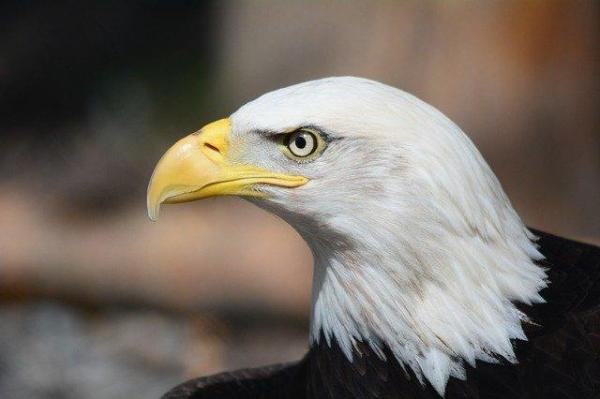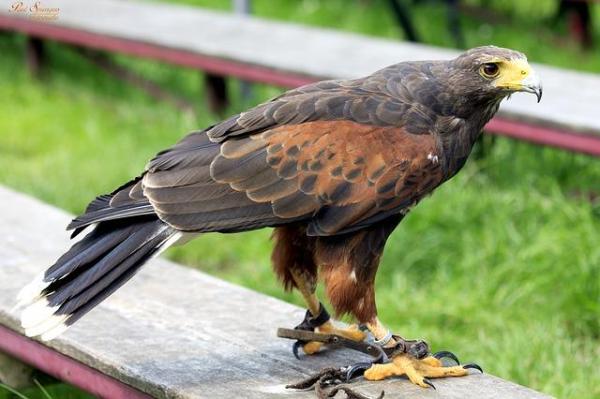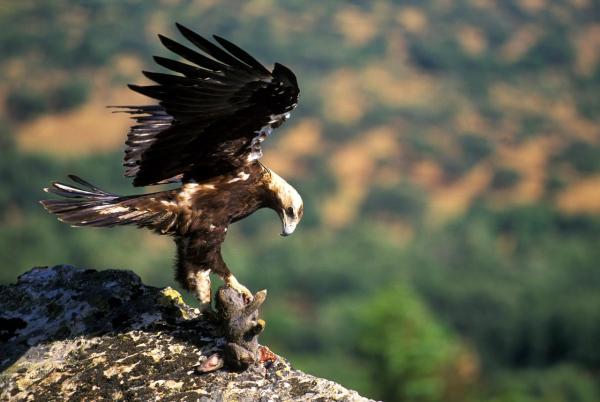
Eagles are among the most powerful birds of prey. With their massive wingspans, razor-sharp talons, and keen intelligence, these birds dominate the skies and serve as top predators in many ecosystems. But what exactly makes eagles so unique? From their legendary eyesight that allows them to spot prey from miles away to their high-speed aerial dives and strong beaks built for tearing flesh, eagles possess remarkable traits that set them apart from other birds.
In this AnimalWised article, we’ll explore the key characteristics of eagles, their hunting strategies, flight abilities, and how they have adapted to survive in diverse environments.
Physical characteristics of eagles
Eagles are nature's aerial predators, with bodies engineered for hunting success. Let us take a closer look at some of their most distinctive physical characteristics:
Wings:
Their wingspan ranges from 1 meter (3.3 feet) in smaller species to over 2 meters (6.6+ feet) in the largest. These wings are wide, long, and rectangular with "fingered" tips where the primary feathers separate, allowing for maneuverability and efficient soaring.
Body:
The eagle's body measures between 40 to 90 centimeters (16 to 35 inches) in length, topped with a hooked beak designed for tearing flesh.
This beak works with their curved talons that grip prey with strength. These features, combined with eyesight 4-8 times stronger than humans, make eagles effective hunters from high altitudes.
Plumage:
Most eagles have brown plumage, though some species appear gray or whitish, providing camouflage suited to their environments. Their rounded tail with an outward-pointing tip helps distinguish eagles from other birds of prey.
Sexual dimorphism:
Female eagles typically outsize their male counterparts, with this size difference being more noticeable in smaller eagle species like harriers, where males and females may even show different coloration. Young eagles look different from adults, gradually developing their mature plumage with age.

What do eagles eat?
Eagles consume a diverse diet that varies significantly by species, habitat, and seasonal availability. Their powerful digestive systems efficiently process various prey, supporting their position as top predators in their ecosystems.
The diet of eagles directly connects to their evolutionary adaptations and habitat, let us look at some common examples:
- Bald eagles (Haliaeetus leucocephalus): primarily consume fish, which comprise 60-90% of their diet in most regions. They target species like salmon, trout, and catfish, but readily supplement with waterfowl, small mammals, and carrion when fishing conditions are poor.
- Golden eagles (Aquila chrysaetos): maintain a land-based diet centered on medium-sized mammals, such as: rabbits, hares, and ground squirrels. In some regions, they regularly take birds, reptiles, and even young ungulates like deer fawns.
- Harpy eagles (Harpia harpyja): of Central and South American rainforests specialize in arboreal mammals, capturing monkeys and sloths directly from tree branches, showcasing their exceptional maneuverability within forest canopies.
- Crowned eagles (Stephanoaetus coronatus): have perhaps the most mammal-specialized diet among eagles, regularly hunting primates, hyraxes, and small antelopes weighing up to 20 kg (44 lbs). In fact, their prey can exceed their own body weight.
Additionally, eagles demonstrate dietary flexibility throughout the year. During salmon runs, bald eagles may gather in large numbers at spawning grounds, capitalizing on this abundant but temporary food source. When winter freezes limit access to fish, they increase scavenging behavior and target waterfowl concentrations.
Many eagle species adjust their hunting patterns to coincide with prey abundance cycles. The golden eagle times its breeding season to coincide with peak rabbit availability, ensuring sufficient food for growing eaglets.
This dietary versatility, which combines specialization with opportunism, allows eagles to thrive across diverse environments and changing seasonal conditions, highlighting their adaptability as predators.

How do eagles hunt?
Eagles are apex predators whose bodies evolved perfectly for hunting. Though hunting strategies differ across species and habitats, their success relies on a combination of vision, speed, and strength.
With eyesight capable of spotting prey from over 1.6 kilometers (1 mile) away, eagles patrol from heights of 30-90 meters (100-300 feet), constantly scanning below.
Upon locating a target, they can plummet at astonishing speeds between 160-320 km/h (100-200 mph), giving prey almost no opportunity to flee. The golden eagle (Aquila chrysaetos) often enhances its approach by using terrain features for concealment, staying hidden behind hills or trees until the final moment of attack.
Water specialists like the bald eagle (Haliaeetus leucocephalus) and African fish eagle (Haliaeetus vocifer) focus on aquatic prey, extending their talons forward during precise water strikes to seize fish swimming near the surface. Though capable of carrying catches equal to their body weight, they sometimes need to drag particularly large fish to shore.
Finally, some eagle species show incredible coordination by hunting in pairs, with one bird driving prey toward its waiting partner.
Fascinated by these aerial predators? Discover more about the hunting strategies eagles use to dominate their ecosystems in our in-depth exploration of their predatory techniques.

How do eagles reproduce?
Eagles employ reproductive strategies that combine lifelong partnerships with dedicated parenting. Their approach to reproduction reflects their status as apex predators who invest heavily in raising fewer, well-developed offspring rather than producing many young with minimal care.
How do eagles mate?
Eagles are monogamous animals, typically mating for life. At the end of winter, pairs reunite and perform spectacular nuptial flights that strengthen their bond. These aerial displays include dramatic maneuvers with steep dives and climbs, talon-grasping where pairs lock feet and spiral downward, and food exchanges when males present prey to females.
Throughout this period, they mark their territory with distinctive calls, warning other eagles to keep their distance. These behaviors not only synchronize the breeding condition of both partners but also reaffirm their exclusive claim to the breeding territory.
Do they use internal or external fertilization?
Eagles reproduce through internal fertilization. The male eagle transfers sperm to the female during copulation, which typically occurs multiple times during the breeding season.
How are eagles born?
After courtship, eagles begin preparing their nest, typically built from sturdy sticks and often reused year after year with new materials added each breeding season. Most eagles place these nests (called eyries) in tall trees or on cliff ledges, though harriers and smaller eagle species prefer nesting in bushes or directly on the ground. The location choice balances safety from predators with access to hunting grounds. Over time, these continuously expanded structures can become massive. In fact, some nests have measured 2.5 meters (8 feet) across and weighed over a ton after years of additions.
Following mating, the female lays 1-3 eggs depending on the species. During the incubation period of 35-45 days, the parents establish an efficient division of labor: the female typically remains on the eggs providing warmth and protection, while the male hunts and brings food to his mate. This arrangement ensures the eggs are constantly protected while maintaining the female's strength for the demands ahead.
When the eaglets hatch, both parents participate in their care, though the female generally dedicates more time to direct nurturing. The parents take turns hunting and bringing food to the nest, gradually increasing the amount as the young grow. This intensive care continues for 10-14 weeks until the young fledge, and even after leaving the nest, juvenile eagles often remain dependent on their parents for several additional months while developing the complex hunting skills they need for independence.

What is the largest eagle in the world?
Determining the largest eagle species is complex since size varies between individuals based on factors like habitat quality, food availability, and sex. Therefore, to properly compare these magnificent birds, we need to consider both wingspan and body length. Among the contenders for the title of world's largest eagle are:
- Steller's Sea Eagle (Haliaeetus pelagicus): claims the title of largest eagle. Females of this impressive species can reach a body length of up to 100 centimeters (39 inches) and a wingspan of 2.3 meters (7.5 feet). Their massive yellow beaks and distinctive white shoulders make them easily recognizable.
- White-tailed Eagle (Haliaeetus albicilla): another formidable contender, with females reaching a wingspan between 2.1-2.4 meters (6.9-7.9 feet) and a body length of about 90 centimeters (35 inches). These sea eagles range across Europe and northern Asia.
- Golden Eagle (Aquila chrysaetos): rounds out the top three, with females measuring up to 96 centimeters (38 inches) in length and sporting a wingspan of up to 2.3 meters (7.5 feet). Unlike the sea eagles, golden eagles are primarily land hunters found across North America, Europe, and Asia.
It is worth mentioning that, while these three species are often considered the largest, the Harpy Eagle (Harpia harpyja) of Central and South America, though having a smaller wingspan, has the largest talons and most powerful grip of any eagle.
Did you know there are over 60 species of eagles worldwide, each with unique adaptations and characteristics? Discover the variety of these predators in our visual guide.

Differences between eagles and other birds of prey
While eagles share similarities with other birds of prey, several key differences help identify them in the field. These distinctions reflect evolutionary adaptations to different hunting strategies and ecological niches.
Eagles vs. Falcons
Eagles (Accipitriformes) and falcons (Falconiformes) belong to different taxonomic orders, with their physical differences directly reflecting their distinct hunting approaches.
Most noticeable is their wing structure, since eagles possess broad, rectangular wings with "fingered" tips perfect for extended soaring, while falcons have developed narrower, backward-swept wings without digits, enabling the rapid wing beats that power their lightning-fast hunting style. These wing adaptations perfectly match how each bird hunts, since eagles patiently glide on thermals while scanning large areas below, whereas falcons specialize in high-speed pursuit and dramatic stooping dives.
This hunting specialization extends to their beaks as well. Eagles use a simple but powerful curved hook primarily designed for tearing prey apart, while falcons have evolved a more specialized tool, a serrated beak with a distinctive triangular protrusion that works like a tooth. This adaptation allows falcons to efficiently dispatch prey by severing the spinal cord during their high-speed strikes.
Even their leg structures reveal their hunting preferences. Eagles often have feathered legs extending to their feet for warmth and protection, while falcons maintain bare legs that reduce drag during their remarkable aerial hunting dives, when speed is paramount.
Eagles vs. Vultures
Distinguishing between eagles and vultures in flight is a challenge even for experienced birdwatchers, as both share the Accipitriformes order and display similar dark coloration and broad wings. However, subtle differences in their silhouettes reflect their vastly different ecological roles.
Vultures possess noticeably longer necks than eagles but fly with them pulled close to their bodies, creating a profile where the head barely extends beyond the body line. Eagles, conversely, project their heads forward during flight, creating a more pronounced separation between head and body that gives them their distinctive silhouette.
Their tail shapes further distinguish them because eagles sport longer, rounded tails that provide the maneuverability needed for active hunting, while vultures have evolved shorter, more triangular or wedge-shaped tails better suited for their soaring lifestyle.
These differences directly connect to their flight behaviors. Vultures maximize energy efficiency by riding thermals with minimal wing-flapping and often gather in spiraling groups called kettles, behaviors perfectly adapted for scavengers that must cover vast territories searching for carrion. Eagles, as solitary hunters requiring greater precision to capture live prey, mix patient soaring with more active flight and typically avoid company except during migration or when unusual food abundance temporarily overcomes their territorial nature.
Did you know there are over 500 species of birds that primarily eat meat? From falcons to owls and beyond, discover the diverse world of avian predators in our other article.
If you want to read similar articles to What Makes Eagles Unique?, we recommend you visit our Facts about the animal kingdom category.
- De Juana, E. & Varela, JM (2016): Birds of Spain. Lynx & SEO/Birdlife.
- Dierschke, V. (2008): Birds of Europe . Barcelona, Spain: Omega Editions. p. 256
- Encyclopedia of birds of Spain. SEO/BirdLife - BBVA Foundation. (2008).
- Saito, KEISUKE (2009). Lead poisoning of Steller's sea-eagle (Haliaeetus pelagicus) and whitetailed eagle (Haliaeetus albicilla) caused by the ingestion of lead bullets and slugs. Ingestion of lead from spent ammunition: implications for wildlife and humans . Institute for Raptor Biomedicine Japan.